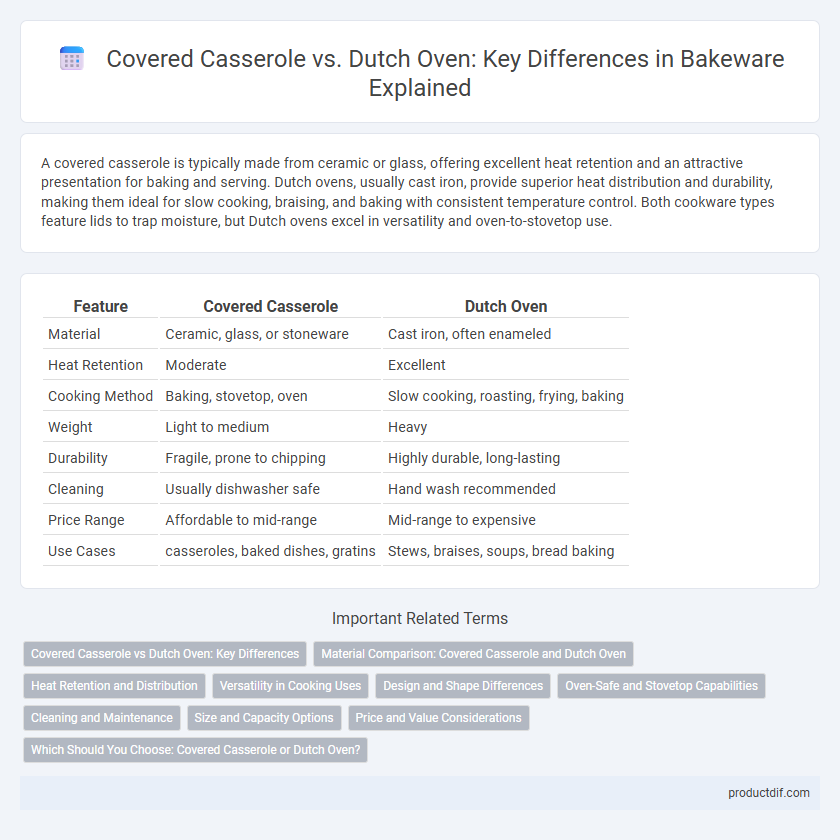A covered casserole is typically made from ceramic or glass, offering excellent heat retention and an attractive presentation for baking and serving. Dutch ovens, usually cast iron, provide superior heat distribution and durability, making them ideal for slow cooking, braising, and baking with consistent temperature control. Both cookware types feature lids to trap moisture, but Dutch ovens excel in versatility and oven-to-stovetop use.
Table of Comparison
| Feature | Covered Casserole | Dutch Oven |
|---|---|---|
| Material | Ceramic, glass, or stoneware | Cast iron, often enameled |
| Heat Retention | Moderate | Excellent |
| Cooking Method | Baking, stovetop, oven | Slow cooking, roasting, frying, baking |
| Weight | Light to medium | Heavy |
| Durability | Fragile, prone to chipping | Highly durable, long-lasting |
| Cleaning | Usually dishwasher safe | Hand wash recommended |
| Price Range | Affordable to mid-range | Mid-range to expensive |
| Use Cases | casseroles, baked dishes, gratins | Stews, braises, soups, bread baking |
Covered Casserole vs Dutch Oven: Key Differences
Covered casseroles are typically made of ceramic or glass, offering excellent heat retention and even cooking, ideal for baking and serving. Dutch ovens are usually cast iron with a heavy, tight-fitting lid, providing exceptional heat distribution and moisture retention, perfect for slow-cooking, braising, and stovetop use. The key differences lie in material, heat conduction, versatility, and cooking methods suited to each cookware type.
Material Comparison: Covered Casserole and Dutch Oven
Covered casseroles are typically made from ceramic or glass, offering excellent heat retention and even cooking ideal for slow baking and serving. Dutch ovens are crafted from cast iron, often coated with enamel, providing superior heat distribution, durability, and suitability for stovetop and oven use. The choice between ceramic and cast iron primarily impacts heat conduction, weight, and maintenance requirements.
Heat Retention and Distribution
A Dutch oven, typically made of cast iron with an enamel coating, excels in heat retention and even distribution, maintaining steady temperatures ideal for slow-cooking and braising. Covered casseroles, often crafted from ceramic or glass, provide moderate heat retention but can heat less uniformly, which may affect cooking consistency. The superior thermal mass of a Dutch oven ensures prolonged, stable heat, while covered casseroles offer convenient use with faster heating times but less efficiency in maintaining temperature.
Versatility in Cooking Uses
Covered casseroles excel in oven-to-table convenience, ideal for baking, roasting, and slow cooking with even heat distribution and moisture retention; their ceramic or glass construction suits casseroles, lasagnas, and braised dishes. Dutch ovens offer superior versatility with heavy cast iron construction, enabling stovetop to oven transitions, perfect for searing, frying, simmering, and baking bread due to their excellent heat retention and durability. Both bakeware types enhance cooking versatility but Dutch ovens provide a broader range of techniques across various heat sources.
Design and Shape Differences
Covered casseroles typically feature a shallow, wide design with straight sides and a tightly fitting lid, ideal for baking and serving casseroles, lasagnas, or gratins. Dutch ovens have a deeper, rounder shape with thick walls and a heavy, domed lid designed to retain moisture and evenly distribute heat for slow cooking and braising. The heavier construction and enamel coating of Dutch ovens distinguish them from the lighter, often ceramic-covered casseroles.
Oven-Safe and Stovetop Capabilities
Covered casseroles are typically oven-safe up to 450degF, offering excellent heat retention for slow-cooked recipes but generally lack stovetop compatibility due to materials like ceramic or glass. Dutch ovens, often made from cast iron or enameled cast iron, are both oven-safe and suitable for stovetop use, allowing seamless transitions from browning on the stove to baking in the oven. The superior heat distribution and durability of Dutch ovens make them versatile for a wide range of cooking techniques requiring simultaneous stovetop and oven capabilities.
Cleaning and Maintenance
Covered casseroles often feature ceramic or glass surfaces that resist staining and can be cleaned easily by hand or dishwasher, making maintenance straightforward and convenient. Dutch ovens, typically made of cast iron with an enamel coating, require careful cleaning to avoid chipping the enamel; hand washing with mild detergent and thorough drying prevents rust and extends their lifespan. Both bakeware types benefit from avoiding abrasive scrubbers to maintain surface integrity and optimal performance over time.
Size and Capacity Options
Covered casseroles typically offer a wide range of sizes from 1 to 5 quarts, ideal for individual servings to family-sized meals. Dutch ovens are generally larger, with capacities ranging from 4 to 8 quarts, making them suitable for slow-cooking, braising, and batch cooking. The choice depends on meal size requirements and cooking versatility, with Dutch ovens providing more volume for larger dishes.
Price and Value Considerations
Covered casseroles generally come at a lower price point compared to Dutch ovens, making them a more budget-friendly option for everyday use. Dutch ovens, often made from cast iron with enamel coatings, offer superior heat retention and durability, delivering greater long-term value despite a higher upfront cost. Investing in a Dutch oven ensures versatile cooking performance and longevity, which can outweigh the initial price difference.
Which Should You Choose: Covered Casserole or Dutch Oven?
Covered casseroles offer lightweight, often glass or ceramic construction, ideal for oven-to-table serving and gentle heat distribution, while Dutch ovens provide heavy-duty cast iron or enameled materials suited for high-temperature searing and slow-cooking versatility. Choosing between a covered casserole and a Dutch oven depends on your cooking style: opt for a covered casserole for casseroles and baked dishes requiring even, moist heat, and select a Dutch oven for braising, roasting, and stovetop-to-oven recipes demanding superior heat retention. Both bakeware options enhance kitchen efficiency but differ in durability, heat capacity, and visual presentation, making your decision pivotal for optimal culinary results.
Covered casserole vs Dutch oven Infographic

 productdif.com
productdif.com